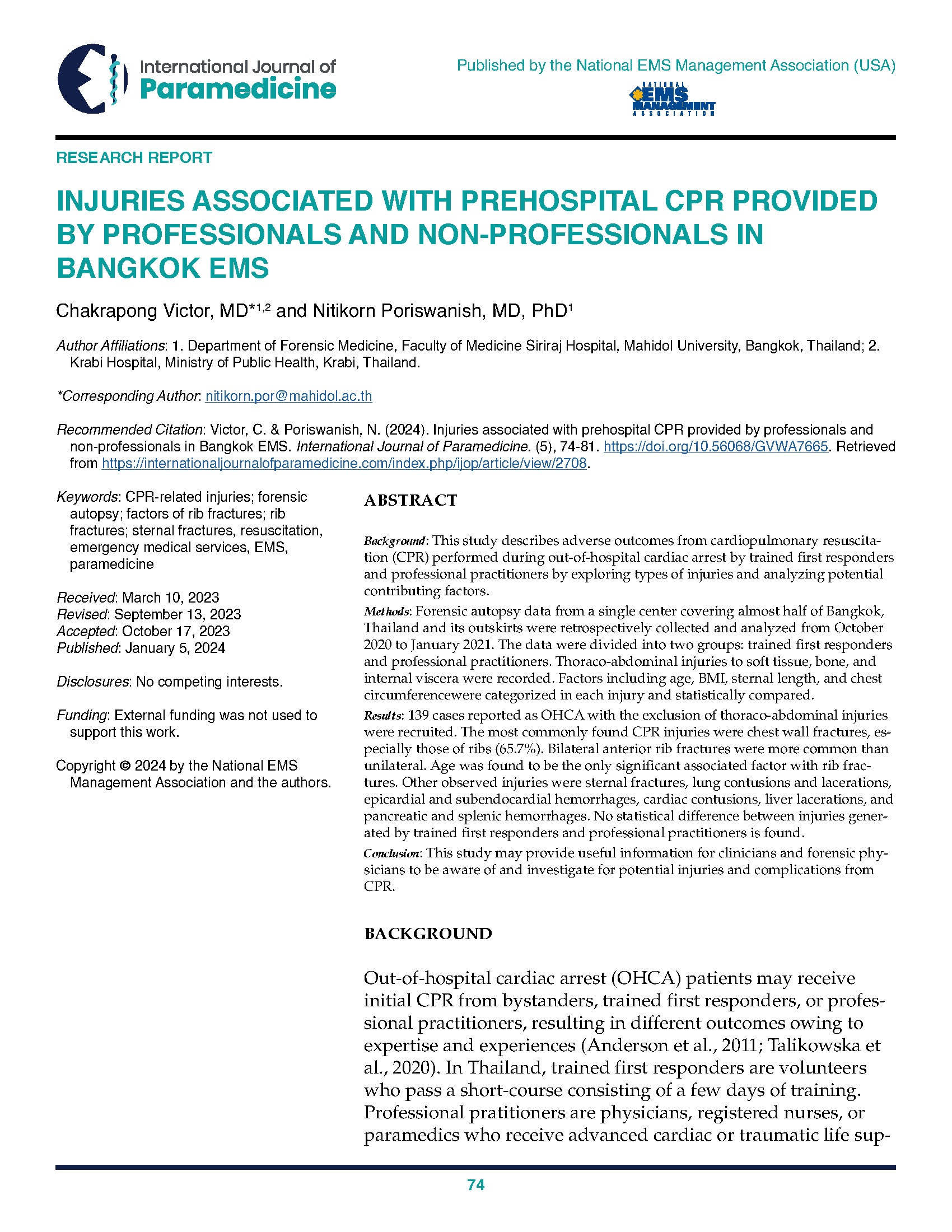Injuries Associated with Prehospital CPR Provided by Professionals and Non-Professionals in Bangkok EMS
Main Article Content
Abstract
Background: This study is to concentrate on adverse outcomes of CPR in out-of-hospital cardiac arrest (OHCA) among different performers that are trained first responders, professional practitioners, and automated devices by exploring types of injuries and comparing between datasets. It is also to find out potential contributing factors for each injury which display statistical significance.
Methods: Forensic autopsy data from a single center covering almost half of Bangkok and her outskirts which were performed during October 2020 to January 2021 were retrospectively collected and analyzed. The data were divided into 3 groups, namely, TFR (trained first responder), PP (professional practitioner), and Auto (automated device i.e. LUCAS system). Thoraco-abdominal injuries were recorded including soft tissue, bone and internal viscera. Factors including age, BMI, sternal length (SL) and chest circumference (CC) were categorized in each injury. Statistical comparison between groups and analysis for significant factors were performed.
Results: A total number of 158 cases reported as OHCA with exclusion of thoraco-abdominal injuries were recruited. The most commonly found as a hallmark of CPR injuries are chest wall fractures especially those of ribs (65.7%). Bilateral anterior rib fractures are more common than unilateral. Significantly associated factors to rib fractures are age and BMI. Other injuries are sternal fractures, lung contusions and lacerations, epicardial and subendocardial hemorrhages, cardiac contusions, liver lacerations, and pancreatic and splenic hemorrhages. No statistical difference between injuries generated by trained first responders and professional practitioners. LUCAS devices show higher incidence of injuries than manual CPR.
Conclusion: This study may provide useful information for clinicians to investigate and monitor potential CPR complications as well as for forensic physicians to concern the injuries possibly caused by CPR.
Article Details

This work is licensed under a Creative Commons Attribution-ShareAlike 4.0 International License.
Publishing in IJOP allows authors to keep their copyright while giving IJOP unrestricted copyright permissions. Articles published in IJOP use Creative Common Attribution 4.0 International (CC BY-ND 4.0) licensing. This license requires that re-users give credit to the creator. It allows re-users to copy and distribute the material in any medium or format in unadapted form only, even for commercial purposes. Additional terms apply and can be accessed here.
Publishing in IJOP also allows authors to have contracts for non-exclusive distribution of the Journal's published version of the article, such as posting to an institutional repository or publication in a book, on the condition that the original publication in the original layout format in IJOP is retained and acknowledged.
We permit and encourage authors to post the articles they published in IJOP on their affiliated websites. This helps share the information, encourages citation in other works, and promotes scholarly discourse in the spirit of open access.
References
Anderson, G. S., Gaetz, M., & Masse J. (2011). First aid skill retention of first responders within the workplace. Scand J Trauma Resusc Emerg Med, 19, Article 11. https://doi.org/10.1186/1757-7241-19-11
Boland, L. L., Satterlee, P. A., Hokanson, J. S., Strauss, C. E., & Yost, D. (2015). Chest compression injuries detected via routine post-arrest care in patients who survive to admission after out-of-hospital cardiac arrest. Prehosp Emerg Care, 19(1), 23-30. https://doi.org/10.3109/10903127.2014.936636
Charaschaisri, W., Jongprasartsuk, K., Rungruanghiranya, S., & Kaufman, L. (2011). Forensic aspect of cause of subendocardial hemorrhage in cardiopulmonary resuscitation cases: chest compression or adrenaline. Am J Forensic Med Pathol, 32, 58–60. https://doi.org/10.1097/PAF.0b013e3181edee46
Deliliga, A., Chatzinikolaou, F., Koutsoukis, D., Chrysovergis, I., & Voultsos, P. (2019). Cardiopulmonary resuscitation (CPR) complications encountered in forensic autopsy cases. BMC Emerg Med, 19(1), Article 23. https://doi.org/10.1186/s12873-019-0234-5
Friberg, N., Schmidbauer, S., Walther, C., & Englund, E. (2019). Skeletal and soft tissue injuries after manual and mechanical chest compressions. Eur Heart J Qual Care Clin Outcomes, 5(3), 259-265. https://doi.org/10.1093/ehjqcco/qcy062
Girotti, P., Rizzuto, A., Orsini, V., Hodja, V., & Koenigsrainer, I. (2022). Heart injuries related to cardiopulmonary resuscitation: a risk often overlooked. Rev Cardiovasc Med, 23(2), Article 61. https://doi.org/10.31083/j.rcm2302061
Kaldırım, U., Toygar, M., Karbeyaz, K., Arzıman, I., Tuncer, S. K., Eyi. Y. E., & Eroglu, M. (2016). Complications of cardiopulmonary resuscitation in non-traumatic cases and factors affecting complications. Egypt J Forensic Sci, 6(3), 270-274. https://doi.org/10.1016/j.ejfs.2015.07.005
Karasek, J., Slezak, J., Stefela, R., Topinka, M., Blankova, A., Doubková, A., Pitasova, T., Nahalka, D., Bartes, T., Hladik, J., Adamek, T., Jirasek, T., Polasek, R., & Ostadal, P. (2021). CPR-related injuries after non-traumatic out-of-hospital cardiac arrest: Survivors versus non-survivors. Resuscitation, 171, 90-95. https://doi.org/10.1016/j.resuscitation.2021.12.036
Kralj, E., Podbregar, M., Kejžar, N., & Balažic, J. (2015). Frequency and number of resuscitation related rib and sternum fractures are higher than generally considered. Resuscitation, 93, 136-141. https://doi.org/10.1016/j.resuscitation.2015.02.034
Moriguchi, S., Hamanaka, K., Nakamura, M., Takaso, M., Baba, M., & Hitosugi, M. (2021). Aging is only significant factor causing CPR-induced injuries and serious injuries. Leg Med (Tokyo), 48, Article 101828. https://doi.org/10.1016/j.legalmed.2020.101828
Patyal, S., & Bhatia, T. (2022). Evaluating costal cartilage for sex and age estimation from PA chest radiographs of North Indian population: A retrospective study. Egypt J Forensic Sci, 12, Article 41. https://doi.org/10.1186/s41935-022-00298-y
Talikowska, M., Ball, S., Rose, D., Bailey, P., Brink, D., Stewart, K., Doyle, M., Davids, L., & Finn, J. (2020). CPR quality among paramedics and ambulance officers: a cross-sectional simulation study. Australas J Paramedicine, 17, 1-11. https://doi.org/10.33151/ajp.17.842
Takayama, W., Koguchi, H., Endo, A., & Otomo, Y. (2018). The association between cardiopulmonary resuscitation in out-of-hospital settings and chest injuries: A retrospective observational study. Prehosp Disaster Med, 33(2), 171-175. https://doi.org/10.1017/S1049023X18000201
Tellson, A., Qin, H., Erwin, K., & Houston, S. (2017). Efficacy of acute care health care providers in cardiopulmonary resuscitation compressions in normal and obese adult simulation manikins. Proc (Bayl Univ Med Cent), 30(4), 415-418. https://doi.org/10.1080/08998280.2017
WHO Expert Consultation. (2004). Appropriate body-mass index for Asian populations and its implications for policy and intervention strategies. Lancet, 363(9403), 157-163. https://doi.org/10.1016/S0140-6736(03)15268-3
Zhang, S., Zhen, J., Li, H., Sun, S., Wu, H., Shen, P., Chen, Z., & Yang, C. (2017). Characteristics of Chinese costal cartilage and costa calcification using dual-energy computed tomography imaging. Sci Rep, 7(1), Article 2923. https://doi.org/10.1038/s41598-017-02859-x

